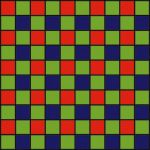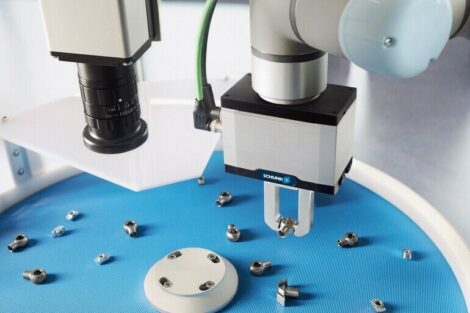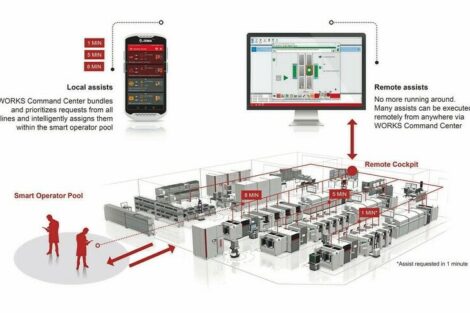When it comes to optical inspection of components on substrate or PCB, does the use of color provide more details and better information on process results than black & white technology?
Marc Stabile and Glenn Wyllie, Vi Technology
On the surface, the question seems to make sense. We might think that a brown capacitor on a green board is likely to show up as gray-on-gray when using a b&w camera. With color, on the other hand, we should be able to see a distinction between the brown of the capacitor and the green of the board. The possible assumption: AOI systems with b&w cameras are at a disadvantage. Well, the answer is not quite that simple. In fact, just the opposite is more apt to be true. Here’s why.
Simple facts of CCD color camera technology
An AOI system uses a CCD camera for imaging, which means that the incoming light is received by a piece of silicon with light-sensitive cells instead of film. This silicon chip is called a charge-coupled device or CCD. Each individual cell or photodiode is an element of the CCD array, and is generally known as a pixel. The camera in an AOI inspection station contains literally tens of thousands of pixels, the actual number depending on the size of the array (640 pixels high by 480 pixels wide being one popular example). As a photon of light hits a pixel, an electron is released, and as long as impingement continues, electrons accumulate in the pixel and are ultimately counted, processed, and converted into an image on a video monitor.
The reality of AOI technology is that CCD chips are inherently black & white devices. This is true because a CCD cannot detect color, only the brightness of light striking it. The pixel array, then, is essentially a 2D plot of light intensity versus position. In dealing with this fact, some different types of color cameras have been developed. There is the one-chip camera with its most common type, the color mosaic camera. This design incorporates a single CCD chip, much like a b&w camera. Color imaging requires three different maps, one each for the colors of red, green and blue (additive mixing). Thus, the surface layer of the CCD is coated with a filter to separate the pixels into the three color planes.
The filter material is applied such that each individual pixel is covered by a separate color filter of either red, green, or blue in a prescribed pattern. The pattern employed most often is the G-R-G-B Bayer pattern. It is biased toward green colors, since the eye is known to be more attuned to green than either red or blue. As can be seen from the figure with the Bayer pattern, half of the pixels measure green, while a quarter of the pixels measure red, and the remaining pixels measure blue. Other patterns can be used, and the actual percentage of each can vary with the design of the camera manufacturer. (Some, for instance, choose to provide one-third of pixels with red filters, one-third with green filters, and one-third with blue filters.)
The problem with the color mosaic camera is that instead of each pixel having measured values for all three filters, only one color is measured per pixel, with no data being provided for the other two colors. Where the data is unavailable, algorithmic interpolation is required, which simply means the missing other two values for each pixel are estimated (based on the surrounding pixels), instead of being measured. In a typical filter pattern, then, many more pixels are interpolated, as opposed to being measured. The net effect is to produce an image with less resolution (image sharpness) than would be the case with all measured values.
The three-chip camera represents a step up in quality (and cost), but it still has inherent problems. A three-chip camera, as the name suggests, incorporates a CCD sensor for each of the three color planes. The light is separated by a prism, with the red, green and blue beams being directed toward the appropriate chip. The good news is, with this type of color camera, the resolution is the same as that of a black & white camera. The bad news is that the accuracy of the image is dependent on the mechanical alignment of the three CCD detectors. For vision inspection systems, CCDs must be aligned within a tolerance of 0.3 micron. Such arrangement must be maintained under varying temperature conditions and, often, under incidences of high acceleration. High acceleration and deceleration of a camera occurs as the platform moves rapidly across the PCB for imaging. High speed is necessary for maintaining throughput, particularly for in-line inspection. Also, with three-chip CCD cameras, light sensitivity is somewhat reduced, which can be a concern, depending on the spot being inspected and its location on the board.
There is actually a third type of camera being passed off as a color camera. Instead of the camera shooting in color, the images themselves are „colorized“. The process is much like the adding of color to b&w movies, and the results are just as unsatisfactory. The images are unnatural looking; and the colors, in effect, degrade the ability to see detail.
With either the color mosaic or the three-chip camera, optic quality is critical. For each lens system, different wavelengths of light will come into focus in different planes. This is because in designing a lens group, the optical engineer is required to accommodate the various aberrations of the array in order to maximize the resolution and contrast of the image. Such conditions include curvature of field, spherical aberration, lateral chromatic aberration, distortion and coma. Due to these complications and other effects, lens systems are rarely able to bring the red, green and blue light beams into focus at the same time. As one might guess, b&w cameras are unaffected by any of the above limitations, as there is no need to individually filter pixels or separate light with a prism.
A final point to remember with color cameras is that image analysis may often only be applied in one of the three elementary color planes (red, green, blue). This process is commonly called color pass through, in that the image is passed through to the operator via a color video monitor, but is only analyzed by the system via customary gray-scale correlation techniques on only one of the three color channels. While the picture on the screen might look nice, the accuracy of inspection is not improved.
The bottom line: seeing the objects
In attempting to inspect surface mount components, the most important consideration is the ability to obtain adequate contrast between the part and the background (the substrate or PCB). With a b&w camera, the process comes down to selecting a source of light that provides the desired result. With a color camera, regardless of the type, the effort is a little more challenging. Adding to the difficulty is the fact that colors vary, depending on the nature of the light and its stability. Various sources of light produce very different effects, which can impact component visibility and mea-surement. For example, daylight and tungsten light have continuous spectra, the light being a blend of all colors, with no discernable gaps between colors.
Despite this basic similarity, however, the light sources differ in color temperature (typically reported in degrees absolute, named after the physicist William Kelvin). Tungsten provides light with a temperature of about 3,200K, while the standardized daylight has approximately 5,600K. (The higher this value, the higher the quantity of the blue spectra.) Every objects derives its color from the wavelengths it reflects, so illuminating parts with different color temperatures inevitably results in a different appearance when viewed by the camera. What this means is that the operator must be adept at recognizing component shapes using the light source provided with the AOI system, and that the stability of the light source is crucial to identification and measurement. Any variation in light color temperature will impact the viewed image. B&w cameras are not as sensitive to varying color temperatures; and the operator simply selects the LED color on the machine that bathes the viewing area and achieves optimum contrast between the component and the board. So then, what about the advantage of being able to see parts in one color and the board in another one? The unfortunate truth is that with color cameras, thousands of colors and shades fade into each other. The color camera captures more than 16 million possible colors (but only a fraction of them can be clearly identified by the eye/mind), with a color image providing over 65 thousand times more information than a b&w image. As a result, the image processing tools require far more time to detect simple features than with a b&w image.
Finally, there’s the matter of white balance. White balance is the adjustment of a color camera so that it shows white parts of the images with almost no color tint. While a person directly viewing an object will see it as being white (if it is white), regardless of the lighting conditions (psychological dependent visual perception), forz color cameras, white light occurs only with an equal combination of the three additive color channels (red, green and blue). Fine-tuning the white balance on a color camera involves precise adjustment of the three CCD outputs, which can be critical to accurately depicting the true colors of the image. If the white color, which is the reference, is off, then the other colors are off as well. As might be guessed, differences in color temperature, and even the ambient lighting, can adversely affect the balance. With a b&w camera, white is just white.
Unless an AOI system is required specifically to inspect a color feature (such as color bands on a through-hole resistor), the use of color is not likely to improve the accuracy or speed. Moreover, color systems require considerably more processing power and complex algorithms in order to verify such basic AOI tasks as component presence, position, and polarity. For practically all machine vision applications, b&w cameras offer distinct advantages in terms of contrast, balance, and resolution in viewing board areas, solder joints and components.
Zusammenfassung
Bringt sie nun mehr Details in die optische Inspektion oder nicht ? Die Auffassungen streben bei Anwendung von Farbe auseinander. Klarerweise läßt sich damit einiges mehr enthüllen bzw. verdeutlichen aufgrund der einfachen Unterscheidbarkeit. Haben doch farbige Stellen gleicher Sättigung identische Grauwerte und sind deshalb in monochromer Technik nicht unterscheidbar. Die Schwarz-Weiß-Technik hingegen ist weniger anfällig gegenüber Fehleinstellungen und durchaus schneller in Bildverarbeitung und Analyse. Vermutlich liegt, wie so oft, die Wahrheit in der Mitte und ist abhängig von der Anwendung.
Résumé
Oui ou non, la couleur est-elle source de plus de détails dans le cadre de l’inspection optique? Les avis quant à l’utilisation de la couleur divergent. Il est clair qu’elle permet de déceler ou de distinguer plus de choses grâce à une différenciation aisée. En effet, les zones de couleur de même saturation ont des valeurs de gris identiques et ne peuvent de ce fait être différentiées avec la technique monochrome. En revanche, la technique noir et blanc est moins sensible aux mauvais réglages et le traitement des images de même que leur analyse sont de ce fait bien plus rapides. Comme souvent, la vérité se situe sans doute entre les deux et dépend de l’application.
Sommario
Fornisce sì o no maggiori dettagli nel controllo ottico? Nell’applicazione del colore, le opinioni differiscono. Naturalmente, con i colori è possibile rivelare o far risaltare più dettagli grazie alla semplice differenziazione. Infatti, le aree colorate e con lo stesso valore di saturazione possiedono identici valori di grigio e non sono differenziabili usando la tecnica monocromatica. La tecnica in bianco-nero è meno sensibile per quanto riguarda gli errori di impostazione e offre un’elaborazione dell’immagine ed un’analisi molto più rapide. Probabilmente, come spesso accade, la verità si trova nel mezzo e dipende da ogni singola applicazione.
Share:











